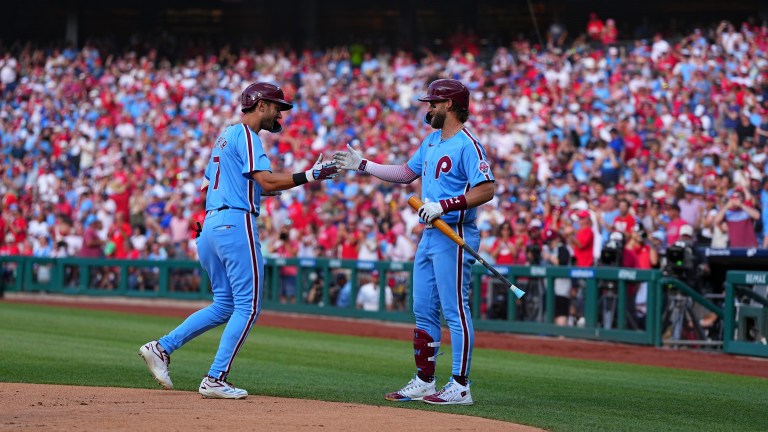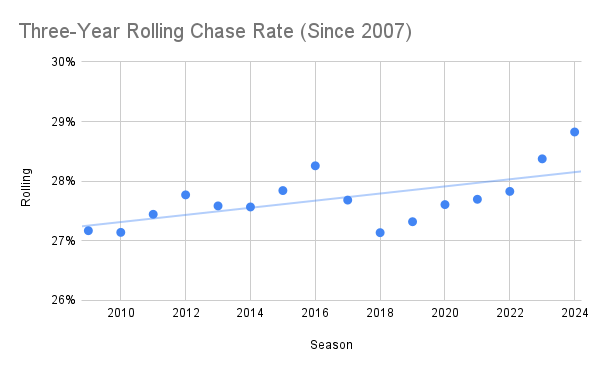The Phillies Are Going To Chase – And That’s Just Fine
This team's propensity for swinging at pitches outside the strike zone might not be the problem some think it is.

Imagine telling yourself in 2008 that “chase” would someday be the Phillies’ downfall in the postseason.
Superstar second baseman Chase Utley became Philadelphia’s own Mr. October throughout the team’s magical five-year run from 2007 to 2011.
He hit 10 postseason home runs. He drove in 25. He crossed the plate 38 times. No one else in franchise history has scored even 30 runs in the playoffs. (Bryce Harper ranks second with 29.)
Yet, in recent years, the word “chase” has taken on a new meaning for this ball club.
To chase, in baseball parlance, means to swing at a pitch outside the strike zone. The Phillies did that quite a bit last season. According to Baseball Savant, they swung at more than 30% of pitches they saw outside the zone. The only NL teams that chased more often were the Rockies and the Marlins. Both those teams lost at least 100 games.
The Phillies continued to chase in the playoffs. The Mets took advantage.
No postseason team saw a higher percentage of pitches outside the zone (57%) than the Phillies. No postseason team had a lower wOBA or xwOBA when they swung at said pitches.
All in all, Philadelphia batters went down swinging 34 times throughout the NLDS. Twenty-five of those swinging strikeouts ended on pitches outside the confines of the strike zone. Just as bad were the 17 pitches outside the zone that the Phillies managed to put in play. The Mets converted each and every one of them into an out.
This wasn’t a new problem, either. The Phillies chased frequently in 2022 and ’23, as well, and it played a role in their postseason ruin each year. Local reporters covered the topic in depth last offseason.
Yet, after their particularly unceremonious ousting in 2024, the Phillies’ propensity for swinging at pitches outside the zone seemed to become a bigger story than ever.
Indeed, their chase rate was a major talking point of the 2024-25 offseason. It’s no coincidence that Dave Dombrowski’s lone offensive addition this winter, Max Kepler, has long shown a sharp eye for the strike zone. Dombrowski emphasized as much at the time of the signing.
Dating back to 2018, Kepler’s low chase rate puts him among the top 25% of MLB hitters. His only Phillies teammate with a lower chase rate in that time (min. 150 PA) is Kyle Schwarber:
| Player | Chase Rate% |
|---|---|
| Kyle Schwarber | 22.1% |
| Max Kepler | 24.3% |
| Brandon Marsh | 26.8% |
| Alec Bohm | 28.5% |
| Bryson Stott | 28.7% |
| Bryce Harper | 29.7% |
| Trea Turner | 29.9% |
| J.T. Realmuto | 29.9% |
| Garrett Stubbs | 31.8% |
| Kody Clemens | 32.1% |
| Johan Rojas | 36.9% |
| Nick Castellanos | 37.8% |
| Edmundo Sosa | 40.0% |
Don’t Sweat the Phillies’ Chase Rate
With all that said, I’m not here to fan the flame of fear about the Phillies and their chasing ways. Instead, my goal is to reassure you that this team’s chase rate isn’t the problem many think it to be.
The Phillies ranked 25th in MLB in chase rate last year. That’s not good. However, it’s worth pointing out that they were more productive than the average team on swings outside the zone.
Statcast Batter Run Value (RV) is a metric that assigns a numerical score to every individual swing (or non-swing) based on how likely it is to lead to a run (or runs). Feel free to skip the next paragraph if you already know how it works.
The average home run had an RV of +1.392 in 2024. The average strikeout had an RV of -0.218. That’s pretty self-explanatory. A homer always leads to at least one run – and sometimes more. Meanwhile, a strikeout almost always reduces a team’s chances of scoring that inning. You can apply the same method of evaluation to every pitch in a game.
According to this metric, Phillies hitters ranked 10th in MLB in RV per pitch on swings outside the strike zone. They ranked 21st in total RV on swings outside the zone. In other words, their chasing didn’t hurt them as much as it could have, because they were better than average at turning those chases into hits or productive outs.
Of course, that’s not enough to justify all their chasing. The 2024 Phillies still had a negative RV on swings outside the strike zone. That’s just inevitable. All 30 teams had a negative RV on swings outside the strike zone. No team in the pitch-tracking era has ever had a positive RV on swings outside the strike zone.
In and of itself, chasing is bad. There’s no room for debate.
But here’s the thing. The only way to avoid chasing entirely is to stop swinging. And if you’ve been watching this Phillies offense for the last few years, you know that’s the last thing they should do.
The Phillies have a damn good lineup when they swing the bat.

The 2024 Phillies ranked second in MLB in RV on swings inside the strike zone. Their +39 RV was only three runs back of the Diamondbacks (+42) in first place and more than twice that of the Astros (+17) in third.
If that doesn’t impress you, consider this: The 2024 Phillies ranked third in MLB in RV on all swings. That’s ridiculous. They ranked 21st in RV when they chased. Yet, they were so productive on swings inside the strike zone that they finished third overall.
Here’s another way to put it: The Phillies ranked fourth in OPS (.720) and third in wOBA (.306) when they swung the bat last season. That’s a major reason why they finished fifth overall in runs scored.
In contrast, the Phillies ranked 10th in RV and ninth in OBP and wOBA when they didn’t swing. So, compared to their fellow teams, the Phillies were a much stronger offense when they swung the bat as opposed to when they left it on their shoulders.
Is that a team you want swinging less often?
Of course, the Phillies would have been even better if they chased a little less. But trying to limit chase comes with the risk of potentially swinging at fewer hittable pitches, too.
Is that a risk the Phillies should be willing to take? I’m not so sure. After all, this was a strong offense in 2024. Why try to fix what isn’t broken?
Are the Phillies on the Cutting Edge?
I’ve said it several times, but the point bears repeating: I’m not arguing that chasing is a good thing. It’s not. By and large, teams with higher chase rates are more likely to have worse offensive numbers.
Take a look at this graph that shows the relationship between chase rate and wRC+ (a comprehensive offensive statistic adjusted for era and ballpark). The data includes every individual team season from 2007-2024, except the shortened 2020 campaign. It’s not hard to see that wRC+ goes up as chase rate goes down:
However, it’s far from a perfect correlation. On the contrary, some of the best offensive teams in recent memory had high chase rates. Just look at the dot standing alone on the upper right side.
That dot is the 2023 Braves, who finished with the highest wRC+ of any team in modern MLB history. And guess what: Their chase rate was almost identical to that of the 2024 Phillies.
It’s not just the 2023 Braves and 2024 Phillies, either.
From 2007 (the first year FanGraphs has the data) to 2018, no team finished with a wRC+ of at least 105 and a chase rate of at least 30%. Good offenses just didn’t chase, simple as that.
Yet, since 2019, 14 different teams have done so – at least one every year. That includes the 2022, ’23, and ’24 Phillies, but eight other organizations too.
That can’t just be a coincidence.
I mean, sure, it could be. Correlation doesn’t imply causation and all that.
But it’s pretty fascinating that no team from 2007-2018 was able to produce a 105 wRC+ with a 30% chase rate, and all of a sudden, it’s become a yearly occurrence.
Surely, it has something to do with the fact that the league-wide chase rate has been increasing steadily since 2018 (remember, wRC+ is league-adjusted), but I think it’s about more than that. More to the point, I think there’s a reason teams are chasing more than they used to.

I wonder if some teams have started to realize that chasing can be part of an effective offensive strategy. It’s like the commercials tell you: Cinnamon Toast Crunch can be part of a healthy breakfast, as long as it’s surrounded by several healthier choices.
If a hitter is talented enough to punish the ball when he makes good contact, a high chase rate can be a reasonable trade-off. That was certainly the case for the Phillies in 2024.
The Phillies Are Chasing Their Dreams

Philadelphia’s aggressive approach worked during the regular season. It failed in the playoffs.
Yet, as frustrating as the NLDS was, it was only four games. The 95 games the Phillies won in the regular season are much more reflective of their true talent than the three games they lost in October.
The Phillies may have chased themselves out of the postseason. But that same approach is what got them to the playoffs in the first place. There’s a reason the Phillies ranked fifth in MLB in runs scored last season. There’s a reason FanGraphs projects them to rank fifth in runs scored once again in 2025.
It might not always be pretty, but it’s what this team is. The Phillies are going to chase – and that’s just fine.


